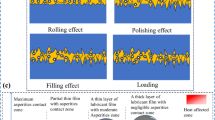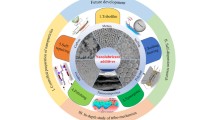Abstract
Superlubricity phenomena, which were previously achieved merely under point contact conditions, have been observed under the linear contact condition between the silicon nitride (Si3N4) cylinder and the silica (SiO2) ring in phosphoric acid solutions. After a total 800 s running-in period and low friction stage, the friction coefficient finally declined to about 0.003. The ultralow friction coefficient could last for more than 5 h. In these experiments, a torque sensor of high accuracy was used to make sure that the measuring result was credible. The differences between superlubricity experiments in our group and others were discussed. Unlike the situations in other superlubricity experiments about silicon nitride, where the specimens were immersed in water totally, the phosphoric acid solution with volume of only 150 μL was used in these tests. It was proved that free water in the solution had a great relationship to the necessary time of acquiring superlubricity and phosphoric acid played a unique role in the superlubricity, which could not be explained properly by the hydrodynamic lubrication model proposed by others. Finally, based on the results of the friction tests and the analysis with scanning electron microscope (SEM), a modified hydrogen-bonded network and hydrated shearing layer model was proposed to explain the mechanism of superlubricity.
Similar content being viewed by others
References
Hirano M, Shinjo K, Kaneko, R. Observation of superlubricity by scanning tunneling microscopy. Phys Rev Lett, 1997, 78(8): 1448–1451
Scherge M, Gorb S N. Biological Micro-and Nanotribology. Heidelberg: Springer, 2001
Dienwiebel M, Verhoeven G S, Pradeep N, et al. Superlubricity of graphite. Phys Rev Lett, 2004, 92(12): 126101
Martin J M, Donnet C, LeMogne T, et al. Superlubricity of molybdenum disulfide. Phys Rev B, 1993, 48: 10583–10586
Jamison W E, Cosgrove S L. Friction characteristic of transition metal disulfides and diselenides. ASLE Trans, 1990, 14(1): 62–72
Stallard J, Mercs D. A study of the tribological behavior of three carbon-based coatings tested in air, water and oil environments at high loads. Surf Coat Tech, 2004, 177: 545–551
Zhou F, Adachi K, Kato K. Friction and wear properties of a-CNx coatings sliding against ceramic and steel ball in water. Diam Relat Mater, 2005, 14: 1711–1720
Donnet C, Belin M, Auge J C. Tribochemistry of diamond-like carbon coatings in various environments. Surf Coat Tech, 1994, 68: 626–631
Klein J, Kumacheva E, Mahal D, et al. Reduction of frictional forces between solid surfaces bearing polymer brushes. Nature, 1994, 370: 634–636
Raviv U, Frey J, Sak R, et al. Properties and interactions of physic-grafted end functionalized poly (ethylene glycol) layers. Langmuir, 2002, 18: 7482–7495
Heuberger M, Drobek T, Spencer N D. Interaction forces and morphology of a protein-resistant poly (ethyleneglycol) layer. Bio Phy, 2005, 88: 495–504
Raviv U, Giasson S, Kampf N, et al. Normal and frictional forces between surfaces bearing polyelectrolyte brushes. Langmuir, 2008, 24: 8678–8687
Chen M, Briscoe W H, Armes S P, et al. Lubrication at physiological pressures by poly-zwitterionic brushes. Science, 2009, 323: 1698–1701
Arad S, Rapoport L, Moshkovich A, et al. Superior biolubricant from a species of red micro algae. Langmuir, 2006, 22(17): 7313–7317
Bongaerts J H H, Justin J, Cooper W, et al. Low biofouling chitosan-hyaluronic acid multi-layers with ultra-low friction coefficients. Biomacromolecules, 2009, 10(5): 1287–1294
Tomizawa H, Fischer T E. Friction and wear of silicon nitride and silicon carbide in water hydrodynamic lubrication at low sliding speed obtained by tribochemical wear. ASLE Trans, 1987, 30(1): 41–46
Chen M, Kato K, Adachi K. The comparisons of sliding speed and normal load effect on friction coefficients of self-mated Si3N4 and SiC under water lubrication. Tribol Int, 2002, 35(3): 129–135
Wong H C, Umehara N, Kato K. Frictional characteristics of ceramics under water-lubricated conditions. Tribol Lett, 1998, 5(4): 303–308
Chen M, Kato K, Adachi K. Friction and wear of self-mated SiC and Si3N4 sliding in water. Wear, 2001, 250: 246–255
Jordi L, Iliev C, Fischer T E. Lubrication of silicon nitride and silicon carbide by water running in wear and operation of sliding bearings. Tribol Lett, 2004, 17(3): 367–376
Xu J G, Kato K. Formation of tribochemical layer of ceramics sliding in water and its role for low friction. Wear, 2000, 245: 61–75
Liu Y H, Wang X K, Liu P X, et al. Modification on the tribological properties of ceramics lubricated by water using fullerenol as a lubricating additive. Sci China Tech Sci, 2012, 55(9): 2656–2661
Liu Y H, Wang X K, Pan G S, et al. A comparative study between grapheme oxide and diamond nanoparticles as water-based lubricating additives. Sci China Tech Sci, 2013, 56(1): 152–157
Li J J, Zhang C H, Luo J B. Superlubricity behavior with phosphoric acid-water network induced by rubbing. Langmuir, 2011, 27(15): 9413–9417
Li J J, Zhang C H, Sun L, et al. Tribochemistry and superlubricity induced by hydrogen ions. Langmuir, 2012, 28(45): 15816–15823
Kalin M, Novak S, Vizintin J. Surface charge as a new concept for boundary lubrication of ceramics with water. J Phys D Appl Phys, 2006, 39: 3138–3149
Raviv U, Klein J. Fluidity of bound hydration layers. Science, 2002, 297: 1540–1543
Li J J, Zhang C H, Ma L R, et al. Superlubricity achieved with mixture of acids and glycerol. Langmuir, 2013, 29: 271–275
Author information
Authors and Affiliations
Corresponding author
Rights and permissions
About this article
Cite this article
Sun, L., Zhang, C., Li, J. et al. Superlubricity of Si3N4 sliding against SiO2 under linear contact conditions in phosphoric acid solutions. Sci. China Technol. Sci. 56, 1678–1684 (2013). https://doi.org/10.1007/s11431-013-5257-7
Received:
Accepted:
Published:
Issue Date:
DOI: https://doi.org/10.1007/s11431-013-5257-7




